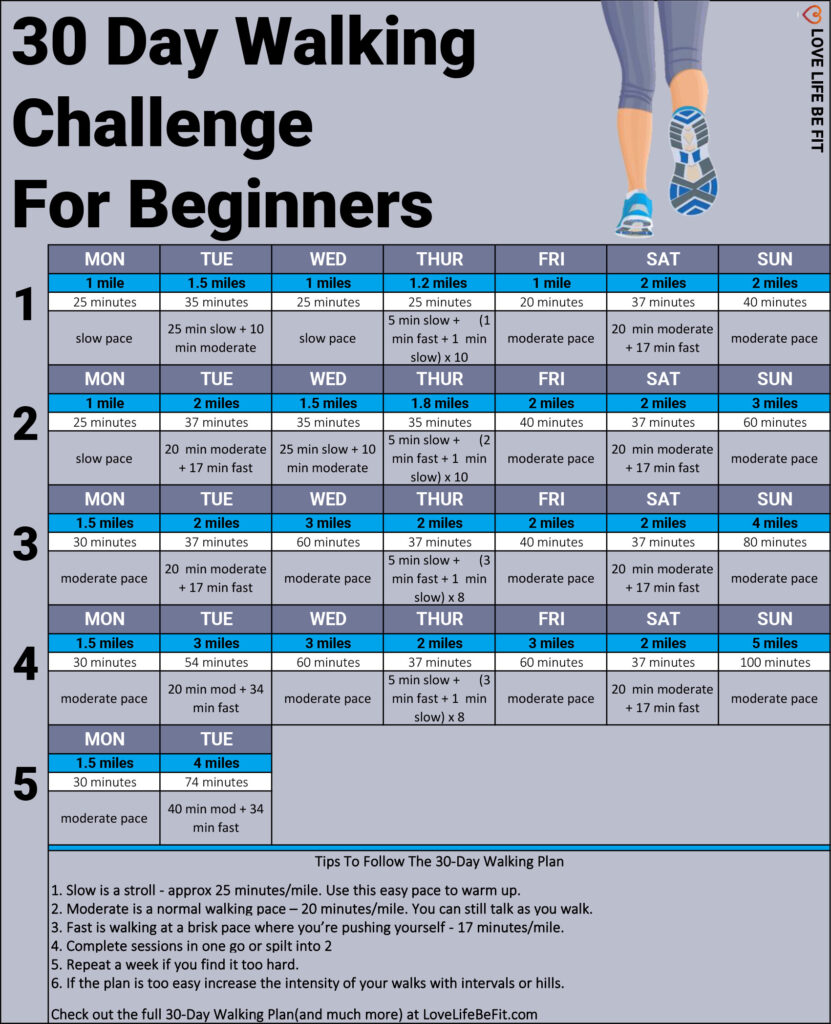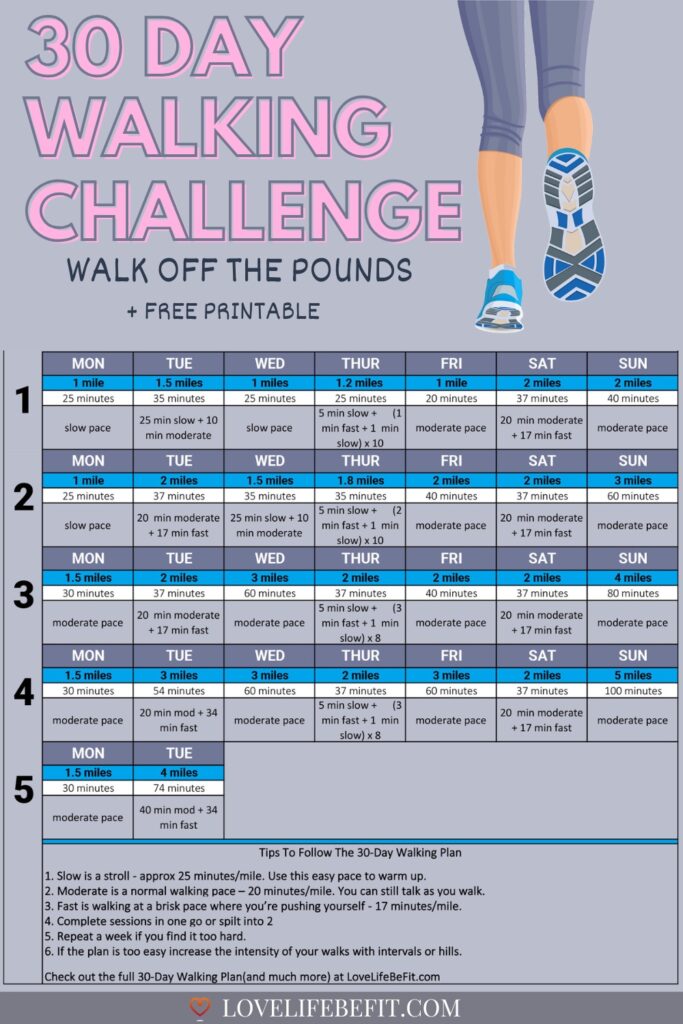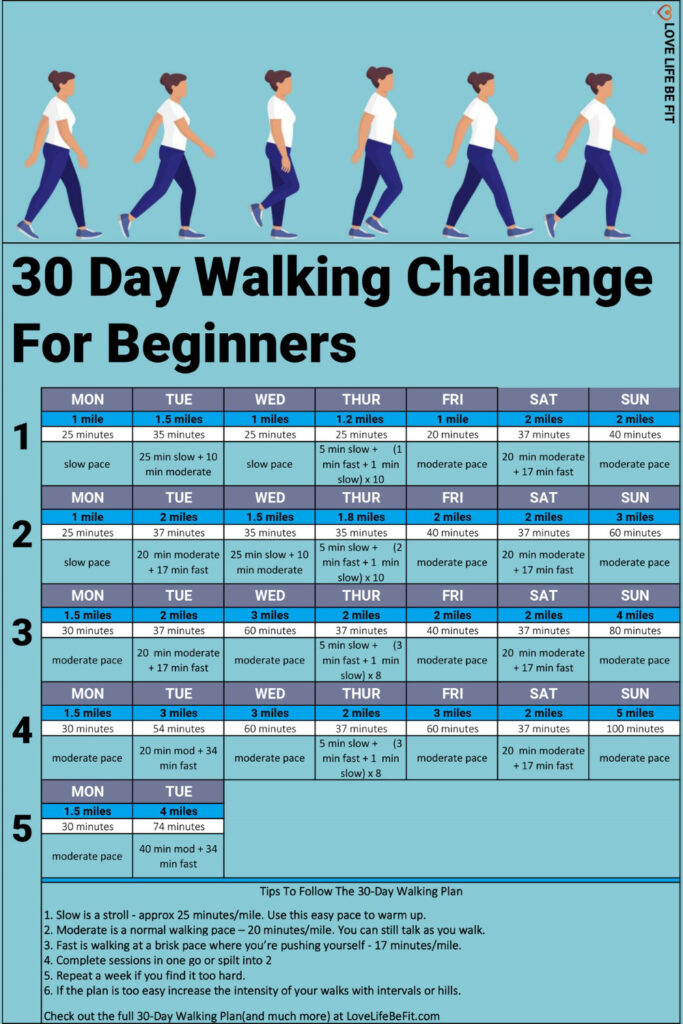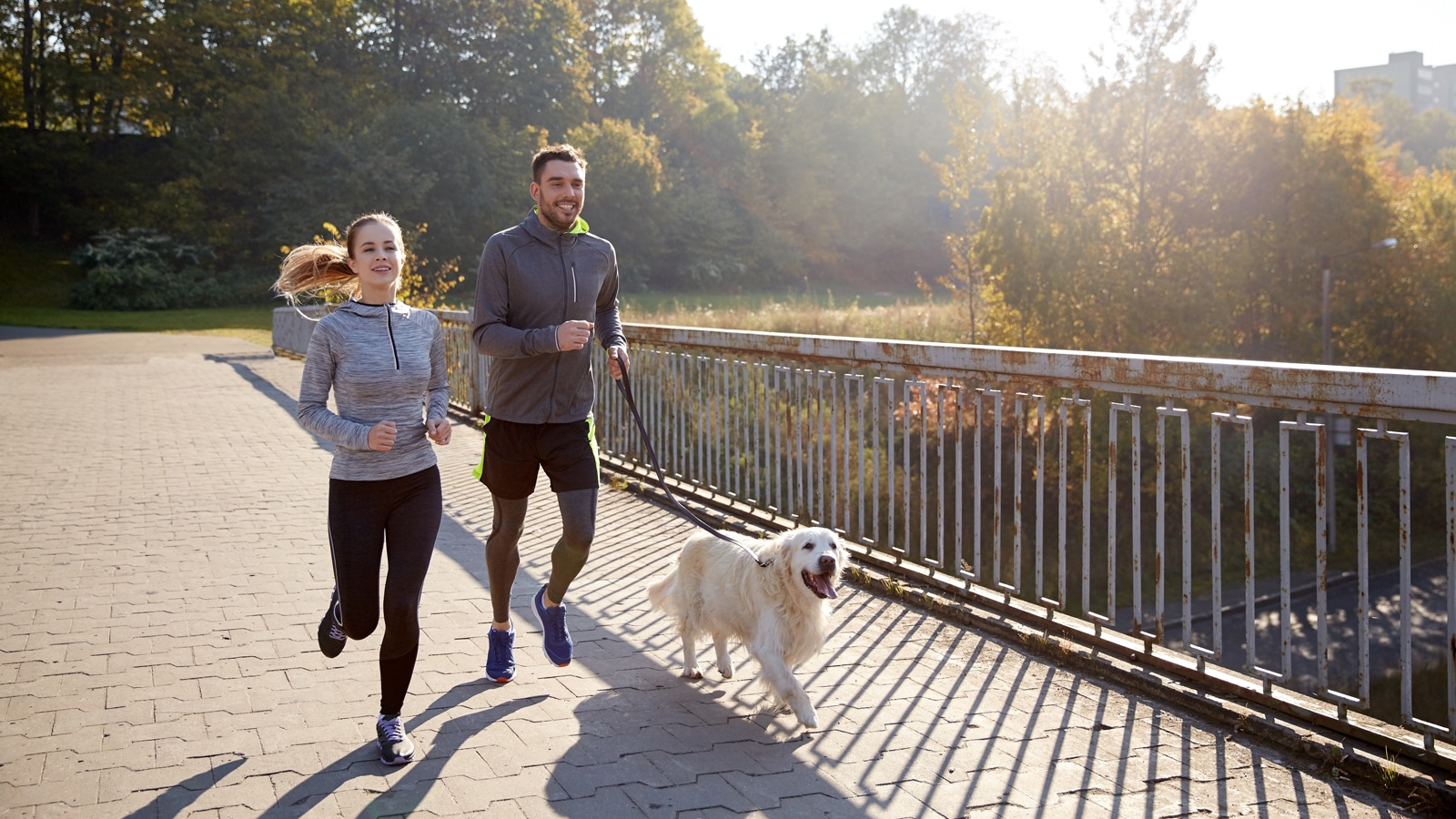30 Day Walking Challenge For Beginners: Get Fit, Lose Weight
Want to get fit? Then try our 30 Day Walking Challenge for beginners. It’s suitable for just about everyone, even if you’ve been completely sedentary for some time.
A walking challenge is a great way to improve your fitness and start your weight loss journey. Walking is low impact, a natural way to exercise, and can kick start your exercise regime.
This printable 30 day walking challenge starts with short walks at an easy pace and slowly builds up the distance and walking speed. It’s completely adaptable. Repeat weeks if the challenge is too hard for your fitness level or skip ahead if your walking is rapidly improving.

Printable 30 Day Walking Challenge
Here’s the 30 Day Walking Challenge for beginners. You can pin the image below to save it or you can download a printable version here. The printable version has check boxes so you can record your progress. We suggest you pin it up somewhere you’ll see it every day such as by your desk or maybe on the fridge!
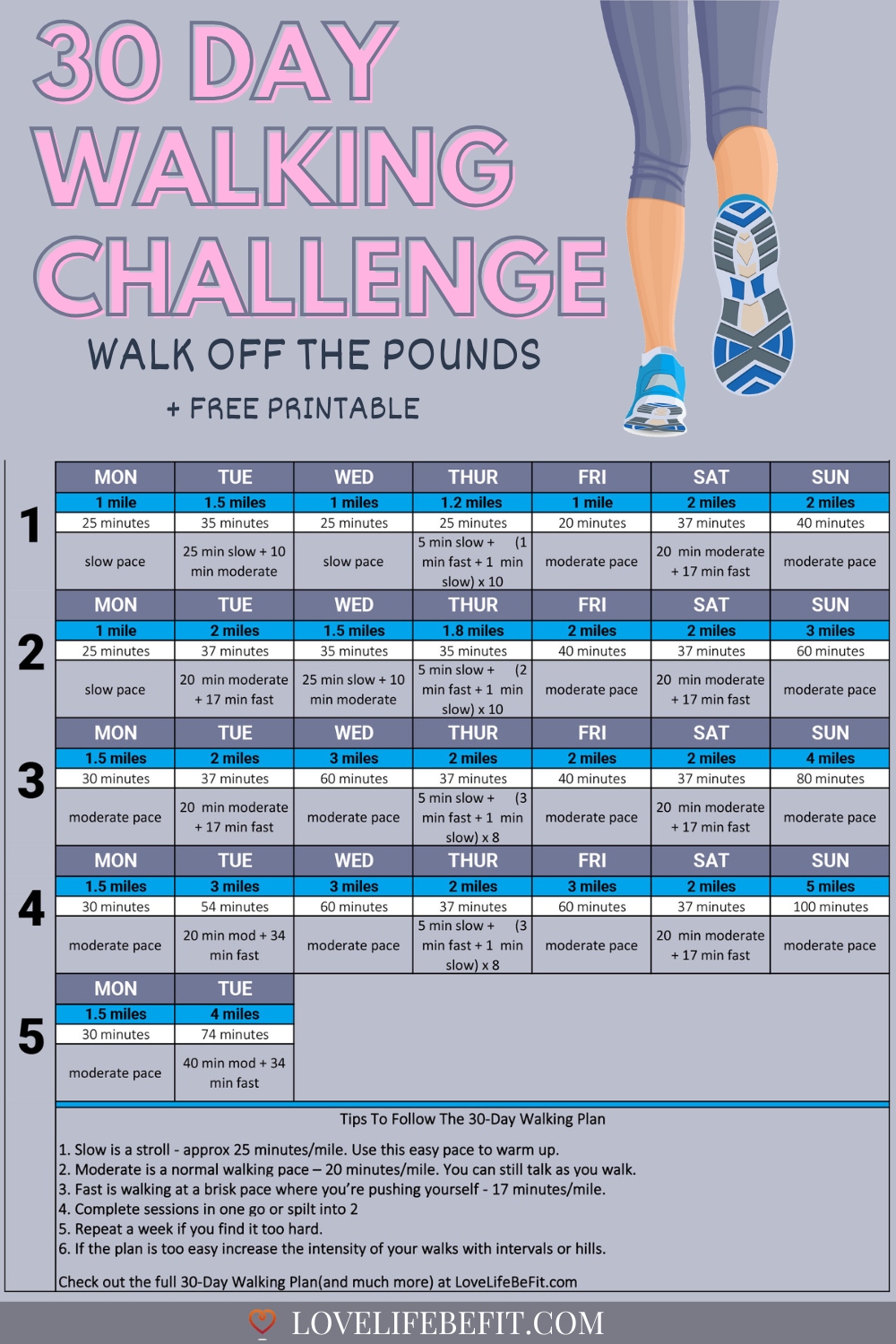
What Is The 30 Day Walking Challenge For Beginners?
This walking routine will ease you into exercising. You will start by walking 1 to 2 miles a day – that’s 20 to 40 minutes of exercise.
This 30 Day Walking Challenge is a little easier than our 28 Day Walking Plan but you’ll still be putting in some hard work!
Daily Walking
The challenge uses walking every day to get you used to regular walking and building a long-term daily habit. Our bodies are designed to walk – it’s a natural exercise. Unlike running, it’s low impact and a safe way to start exercising – even if you’re carrying a lot of excess weight.
These are a few of the benefits:
- Walking improves heart health – walking at a brisk pace can improve your cardiovascular fitness.
- It’s a great way of burning calories – you burn between 80 and 200 calories in a 30-minute walk.
- Walking 30 minutes to walking an hour a day reduces the risk of chronic diseases, helps with your mental health, can reduce high blood pressure, and reduces the risk of Type 2 diabetes. It’s also good for balance and bone strength.
NOTE: It’s always a good idea to get a check-up with a health professional before starting a new exercise routine. It’s especially important if you’re overweight, suffer from any medical conditions, or haven’t exercised for long periods.
Going to the gym, taking an exercise class, or starting running can be intimidating!
But most people walk a little in their daily life, so the walking workouts in the 30 Day Walking Challenge build on your natural walking ability. You’ll start walking at your normal pace and gradually transition to bouts of fast walking.

Rest Days
Normally rest days are important in an exercise schedule to give your body a chance to recover and let your muscles repair and rebuild.
But walking is much gentler on the body than running or lifting weights in the gym and your body benefits from daily movement instead of sitting all day.
So instead of rest days, the walking challenge gives you an easy day every Monday. When you’re tired from a busy weekend you can look forward to a slow or moderate-paced walk for up to 30 minutes.
Treat your Monday workouts as recovery days. Keep the pace easy and just enjoy walking outdoors in the fresh air.
Use these recovery walks to tune into your body and assess any niggles – make sure you get any persistent soreness checked out by a physiotherapist or other health professional.
Walking Workouts
The walking challenge uses three different walking paces – slow, moderate, and fast. The suggested paces are for guidance only. The actual pace will depend on your current fitness level.
Slow is a stroll
Think of this pace as your walking pace if you’re popping out to do some errands or perhaps go for a stroll in your local park. You’re continuously walking but it should feel easy.
The challenge assumes an easy pace is approximately 25 minutes/mile – if your slow is slower (or faster) that’s okay.
Moderate is a normal walking pace
You can still walk and talk comfortably but your walking is more focused than a casual stroll. As you get fitter, your moderate walking will be at a brisk pace where you’re making a continuous effort.
The challenge assumes a moderate pace is approximately 20 minutes per mile. Again, this pace is only a guide.
Fast is walking at a brisk pace.
Your fast walking pace needs to be sustainable. It’s a brisk walking pace where your heart rate is elevated but you should still be able to talk – at least in short sentences.
As your fitness level increases, you’ll be able to push harder. The Thursday sessions are interval walking – alternating fast and slow-paced walking is an excellent way to get a great cardio workout!
The challenge assumes a fast pace is approximately 17 minutes per mile but it’s really down to you and your fitness level.
Distances and times
The walking challenge provides both walking times and mile distances. Stick to whichever is shorter. For example, if the session is one mile at a moderate pace and the time suggested is 20 minutes – end your session at 20 minutes or before if you’ve completed your mile in a faster time.
Will You Lose Weight?
The short answer – is yes you will lose weight!
But there are some provisos.
Taking on a walking challenge is a great way to lose pounds if you have the right mindset.
By this we mean you need to make a conscious decision to change both your exercise and diet habits.
Exercise is just one part of the weight loss equation – what you eat is so important. With the wrong attitude, it’s really easy to treat yourself to cakes and unhealthy snacks at the end of your walks and completely undo all the good work of burning calories.
Find out what to eat after walking for weight loss.
How much weight you lose during this challenge will depend on so many factors such as your current body weight and fitness level but most people can expect to lose one pound a week if they combine walking with a few small changes to their diet.
Find out more about calories burned walking per mile and how much walking for weight loss.
What Happens If I Walk Every Day For A Month?
Some 30 day challenges get you to walk for 10 minutes a day and take plenty of rest days. That might be the right level if you struggle to walk and your fitness level is extremely low.
This plan wants to make a real difference – we’re aiming for life-changing. So it pushes you quite hard.
If it’s too hard and you wake up feeling sore, take a rest day and maybe repeat a week. The sessions get longer as the challenge progresses.
Week 1
Start by writing down your why. Why are you doing this and what will getting fit mean to you? You’ll need those big emotional reasons to keep going as the challenge gets tougher.
Try not to get carried away in week one and stick to the recommended paces. You’re going to be full of enthusiasm but we want that energy to last the whole month. So if the pace says slow – walk slowly!
Don’t expect to lose any weight the first week – you may even gain weight but it’s just going to be water retention. This post about not losing weight walking explains all about inflammation in your muscle fibers and increased muscle glycogen. It’s temporary!
Week 2
This will be the toughest week. Your enthusiasm levels have started to wane, you’re not seeing any results yet and it will be hard work.
Just remember why you’re doing this and believe in the process. It gets easier.
Week 3
Think of this as the breakthrough week. By the time you get to the end of the week, regular walking will be a habit.
Week 3 is when most people notice changes to their bodies. Your clothes may feel a little looser. Hopefully, you’ve lost two or three pounds on the scales.
You’ll feel your muscles getting stronger. A lightness in your steps. walking will be part of your day-to-day life.
Week 4 to 5
This will be a period of overwhelming positivity. You’re likely to be feeling good about your fitness and any weight loss you’ve achieved so far.
The walking sessions are longer and harder but those muscles are ready for the challenge. It feels good to work out and walk your way to a new you!
30 Day Walking Challenge Results
By the end of the challenge, you should have:
- Improved your cardiovascular fitness
- Increased your stamina
- Developed a regular walking habit
- Lost weight and strengthened muscles
You should feel great and ready for your next fitness goal!
The walking challenge won’t be easy. You may have days when you don’t want to go for a walk and times when the thought of walking one more step seems like an impossible task. But stick with it and you’ll soon be reaping the rewards.
Tips For Completing The 30 Day Walking Challenge
These tips will make it easier to complete the walking challenge:
Plan Ahead
Decide what time of day you’re going to walk and where.
It can help to always walk at the same time such as first thing in the morning or the early evening. Put your walks in your schedule and give them priority – this is your health and well-being. It’s important!
Work out some routes. Often it’s best to walk straight from your door to save time but make sure you’re walking in safe areas.
Walk On A Treadmill
You don’t have to walk outside. Some people prefer to walk on a treadmill at home or in their local gym.
Wear Comfortable Shoes
Walking doesn’t need special equipment but it’s important to wear comfortable walking shoes or trainers. It’s best if they’re cushioned and supportive.
Stay Hydrated
Take some water with you on your walks especially when it’s hot. Follow these tips for exercising in the heat.
Split Up The Sessions
You don’t need to do your workouts all in one go. You can split them up into 2 or even 3 sessions if it’s a better fit with your schedule.
Add Strength Training
Bodyweight exercises to work the entire body can help you build the leg and core strength you need for regular walking and will also give your upper body a workout. Try adding 10 to 15 minutes of strength training after your walking sessions 2 or 3 times a week.
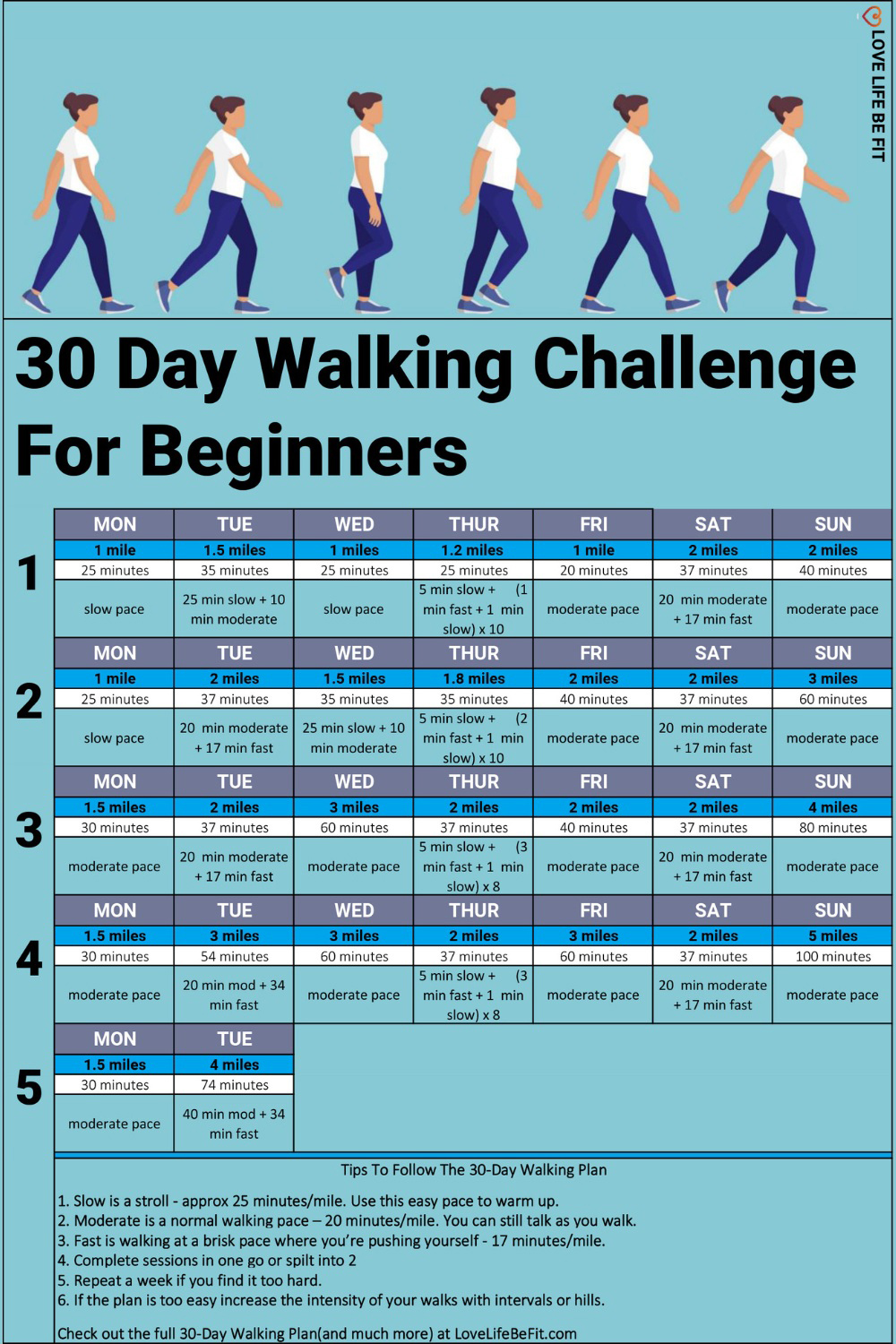
Thoughts From Love Life Be Fit
If you’re starting from a low level of fitness this 30 Day Walking Challenge for beginners is ideal. The sessions start at an easy level and progressively get harder.
If it’s too much and you’re waking up tired and sore, revert to 10-15 minutes of easy walking a day until you feel fit enough to continue the challenge. Or start with this 6-week walking exercise plan.
If it’s too easy try our 28 Day Walking Plan for beginners, our 10,000 Steps Challenge, or our 9-Week Fat Buster Walking Plan.
Running 101 Training Guides & Walking Schedules
5K Training Plans
- Couch To 5K Beginner Training Plan
- 12 Week 5K Training Plan
- 10 Week 5K Training Plan
- 8 Week 5K Training Plan
- 6 Week 5K Training Plan
- 4 Week 5K Training Plan
- 5K Training Plan Intermediate
